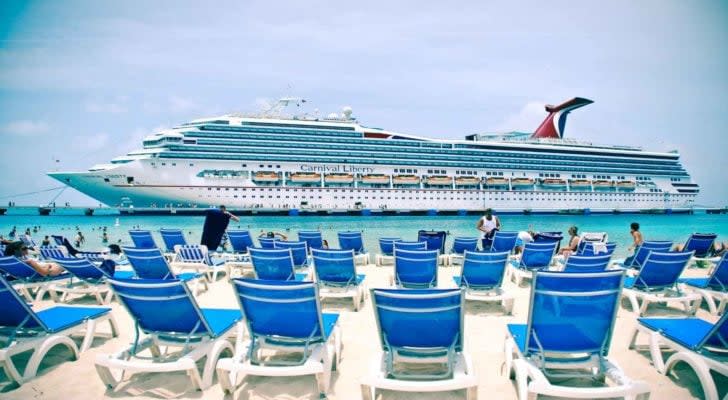An Investment in Carnival Requires a History Lesson
The state of Carnival (NYSE:CCL) is pretty simple. The company is doing everything it can to slow its cash burn while it waits the green light to begin sailing. There are two problems as it relates to Carnival stock.

Source: Flickr
First, nobody knows when that green light will be given. The November start date seems to be a pipe dream. And even with that, Carnival announced in October that it was cancelling all of its U.S. cruises for the rest of the year except for those sailing out of the company’s two homeports.
And second, nobody knows the extent to which passenger traffic will return? There’s nothing the company can do about the first problem. They will sail when they get the OK. The second question is like looking through a glass darkly.
InvestorPlace - Stock Market News, Stock Advice & Trading Tips
The Math Looks Challenging
It’s a fool’s errand to make predictions for the stock of any cruise line. But let’s have some fun. In 2019, Carnival had full-year revenue of $20.82 billion and earnings per share of $4.40.
According to Statista, Carnival had a record 12.9 million passengers. That was nearly half of the 30 million cruise ship passengers worldwide.
So, what would we guess will happen in 2021? Assuming a vaccine is widely available by the middle of the year, could cruise lines get 50% of the 2019 number? If they could, you’d have to go back to about 2004 to find a comparable year for the industry. And in 2004, Carnival brought in $11.1 billion in revenue with earnings per share of $2.70.
This year, Carnival will be lucky to generate $6 billion in revenue. And that’s with a first quarter in which the company generated $4.79 billion.
But I still think that’s too optimistic of a scenario. At the end of 2008, as the Great Recession probably was at its worst, Carnival stock was trading at around $18 per share. That’s not too far from the $15 it trades at as of this writing. But it was a drop from the $40 share it was trading at just three months prior. It took nearly two years for the stock to get back to that level.
When you consider that the cruise line is facing a medical and psychological as well as a financial hurdle, it may be quite some time before Carnival stock is approaching the level of January. And keep in mind, that despite rising passenger counts, Carnival’s price per share was dropping at a steady pace since 2018.
What Will The Future of Cruising Look Like?
Before I get excited enough to invest in cruise lines, I want to hear more about what the future of cruising will look like. I’m not talking about 2021 or 2022. The cruise lines are going to be in an awkward period. Ships that were designed to maximize capacity are going to be retrofitted for social distancing. That’s no fun.
However, what will the cruise ship of the future look like? Cruise lines will have an opportunity to rethink the interior. I suspect the new normal will be cruise ships that have less capacity. But scarcity may have its benefits.
Prior to the pandemic, cruise lines didn’t sale with less than full ships. But if customers are truly harder to win back, limiting the capacity by design could be an interesting approach. Scarcity could make a cruise vacation appear more valuable. This in turn could mean that cruises won’t have to rely on discounted rates to fill their ships.
I’m brainstorming here. The cruise ships themselves won’t be getting smaller. But I do believe any new ships will have to be rethought from stem to stern. If it’s done correctly, this could be a marketing opportunity.
Buying Carnival Stock Requires Loads of Patience
Will people cruise again? Of course they will. The cruise lines themselves are saying that booking numbers are encouraging. But will they cruise in 2021? That remains to be seen. I believe any bet on a Carnival stock recovery is a two-year bet at best. That’s a long time to hold a stock that recently suspended its dividend.
Carnival didn’t do anything to merit its current circumstances. However, that doesn’t mean you should have to suffer with it. If you have the patience to wait this one out, then the price might be right. But with revenue not likely to jump on board until the middle of next year, I would avoid Carnival stock until the seas get calmer.
On the date of publication Chris Markoch did not have (either directly or indirectly) any positions in the securities mentioned in this article.
Chris Markoch is a freelance financial copywriter who has been covering the market for over six years. He has been writing for Investor Place since 2019.
More From InvestorPlace
The post An Investment in Carnival Requires a History Lesson appeared first on InvestorPlace.

